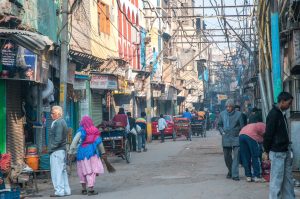When India’s prime minister Narendra Modi addressed the nation on Independence Day, August 15, he outlined an ambitious vision of “Viksit Bharat“ meaning “developed India.” The deadline for this is 2047, the 100th anniversary of independence.
The target may be taken as a real per capita income of $20,000 in current dollar terms. If it gets there, India will find itself in the company of modestly rich European nations, such as Greece.
India’s current per capita income is $2,500, so the nation would need to achieve an eightfold increase in just 23 years. This is akin to chasing a 400-plus score in a one-day international cricket match, on a deteriorating wicket.
For India to reach this target will require bold strategies, Slow-and-steady, incremental policy making won’t be enough. The “asking rate” is 9.4 percent growth in real terms year after year for the next 23 years.
There have been a few such phenomenal chases in history. Some East Asian economies such as South Korea, Singapore, and Taiwan grew from the mid-1960s to the early 1990s at an impressive pace of 8 percent. This is widely known as the East Asian Miracle. After its 1978 reforms, China also achieved its miracle, a nearly 10 percent growth rate over a sustained period.
India will need its own miracle to achieve a similar feat.
Simply copying the East Asian or Chinese models is not an option. The political context of the East Asian and Chinese economies in their high growth phase was very different from the current Indian context. But more importantly, the growth model used by these economies – one of manufacturing and export-led growth — is unlikely to be available to India.
For starters, the current international political climate is not conducive to globalization. Increased protectionism in the U.S. and European Union and the fragility of global supply chains, which became apparent during the 2008 global financial crisis and the COVID-19 pandemic, have reduced openness to trade. The proportion of international trade as a percentage of the world GDP has been shrinking since 2008. Some economists have termed this phenomenon “deglobalization.”
The expansion in economic activity required for India to increase its income eightfold is also much harder to achieve in a world where the threat of climate change is real. It is inconceivable that an economy of the magnitude of India will grow eightfold without leaving behind a major carbon footprint. In a world where there is an increasing consensus on reducing emissions, there will be growing pressure against economies flouting stringent environmental regulations.
Finally, labor-intensive, low-skilled manufacturing is under increasing threat from automation and artificial intelligence. This is one of the reasons why rich countries, with abundant capital but expensive labor, are trying to bring jobs back to their shores using automation technologies such as robotics.
The growth experience of the Western world as well as East Asia (including China) suggests that the typical route to economic prosperity requires the rise of the manufacturing sector and the decline of agriculture as the first step. The rise in services follows only after that. However, India may have to follow a different model of development where growth would be led by the services sector. That is what some prominent economists, such as Dr. Raghuram Rajan and Rohit Lamba, have recently argued.
This may be India’s only shot.
To succeed in this new, services-led paradigm, India will need to embark on economic reforms that encourage the formation of high-skill human capital capable of competing with the best in the world. This will require investment in an education policy that emphasizes creative thinking and entrepreneurial skills over rote learning.
Second, India will need to make its factor market, particularly the labor market, less rigid. This will ensure that firms can increase or reduce their labor forces as required in a rapidly changing technological landscape.
Services-led growth tends to benefit educated people in cities. With rising inequality and rural distress already a major concern, India will need to undertake social sector reforms to ensure that the opportunities, and gains, from a growing services sector are widely shared. Without this, there will be a backlash (as already witnessed during the recent elections), making it politically infeasible to follow the service-led growth model.
In addition to being a desirable goal to strive for, Viksit Bharat 2047 has many symbolic meanings. The date coincides with India completing a century of its independence. The period leading up to it is being dubbed as “Amrit Kaal” – an auspicious era marking India’s manifest destiny to prosperity.
On a more sobering note of demographic transition, it’s also a narrow window of opportunity for India to get rich before getting old.
Originally published under Creative Commons by 360info™.

































